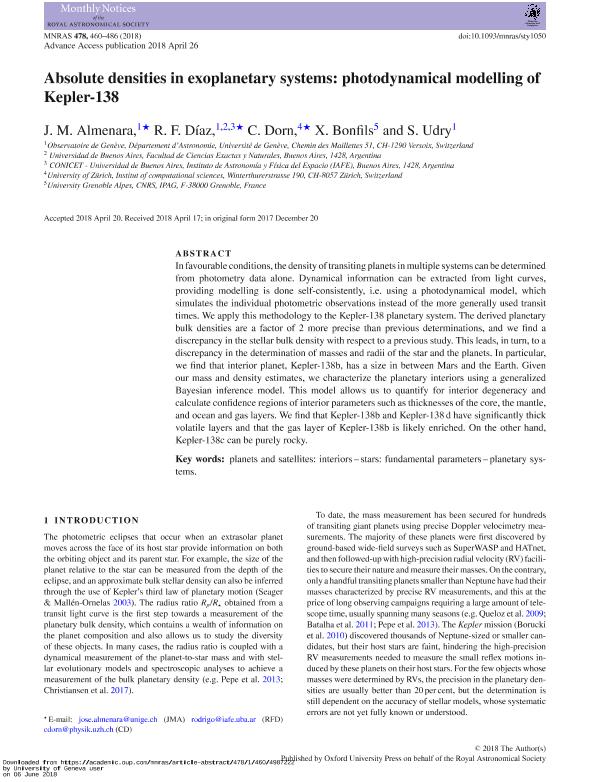Mostrar el registro sencillo del ítem
dc.contributor.author
Almenara, J. M.
dc.contributor.author
Diaz, Rodrigo Fernando

dc.contributor.author
Dorn, C.
dc.contributor.author
Bonfils, X.
dc.contributor.author
Udry, S.
dc.date.available
2019-07-31T14:34:46Z
dc.date.issued
2018-07
dc.identifier.citation
Almenara, J. M.; Diaz, Rodrigo Fernando; Dorn, C.; Bonfils, X.; Udry, S.; Absolute densities in exoplanetary systems: Photodynamical modelling of Kepler-138; Wiley Blackwell Publishing, Inc; Monthly Notices of the Royal Astronomical Society; 478; 1; 7-2018; 460-486
dc.identifier.issn
0035-8711
dc.identifier.uri
http://hdl.handle.net/11336/80652
dc.description.abstract
In favourable conditions, the density of transiting planets inmultiple systems can be determined from photometry data alone. Dynamical information can be extracted from light curves, providing modelling is done self-consistently, i.e. using a photodynamical model, which simulates the individual photometric observations instead of the more generally used transit times. We apply this methodology to the Kepler-138 planetary system. The derived planetary bulk densities are a factor of 2 more precise than previous determinations, and we find a discrepancy in the stellar bulk density with respect to a previous study. This leads, in turn, to a discrepancy in the determination of masses and radii of the star and the planets. In particular, we find that interior planet, Kepler-138b, has a size in between Mars and the Earth. Given our mass and density estimates, we characterize the planetary interiors using a generalized Bayesian inference model. This model allows us to quantify for interior degeneracy and calculate confidence regions of interior parameters such as thicknesses of the core, the mantle, and ocean and gas layers. We find that Kepler-138b and Kepler-138 d have significantly thick volatile layers and that the gas layer of Kepler-138b is likely enriched. On the other hand, Kepler-138c can be purely rocky.
dc.format
application/pdf
dc.language.iso
eng
dc.publisher
Wiley Blackwell Publishing, Inc

dc.rights
info:eu-repo/semantics/openAccess
dc.rights.uri
https://creativecommons.org/licenses/by-nc-sa/2.5/ar/
dc.subject
Planetary Systems
dc.subject
Planets And Satellites: Interiors
dc.subject
Stars: Fundamental Parameters
dc.subject.classification
Astronomía

dc.subject.classification
Ciencias Físicas

dc.subject.classification
CIENCIAS NATURALES Y EXACTAS

dc.title
Absolute densities in exoplanetary systems: Photodynamical modelling of Kepler-138
dc.type
info:eu-repo/semantics/article
dc.type
info:ar-repo/semantics/artículo
dc.type
info:eu-repo/semantics/publishedVersion
dc.date.updated
2019-07-29T14:52:37Z
dc.journal.volume
478
dc.journal.number
1
dc.journal.pagination
460-486
dc.journal.pais
Reino Unido

dc.journal.ciudad
Londres
dc.description.fil
Fil: Almenara, J. M.. Universidad de Ginebra; Suiza
dc.description.fil
Fil: Diaz, Rodrigo Fernando. Universidad de Ginebra; Suiza. Consejo Nacional de Investigaciónes Científicas y Técnicas. Oficina de Coordinación Administrativa Ciudad Universitaria. Instituto de Astronomía y Física del Espacio. - Universidad de Buenos Aires. Facultad de Ciencias Exactas y Naturales. Instituto de Astronomía y Física del Espacio; Argentina
dc.description.fil
Fil: Dorn, C.. Universitat Zurich; Suiza
dc.description.fil
Fil: Bonfils, X.. Universite Grenoble Alpes;
dc.description.fil
Fil: Udry, S.. Universidad de Ginebra; Suiza
dc.journal.title
Monthly Notices of the Royal Astronomical Society

dc.relation.alternativeid
info:eu-repo/semantics/altIdentifier/doi/http://dx.doi.org/10.1093/mnras/sty1050
Archivos asociados
